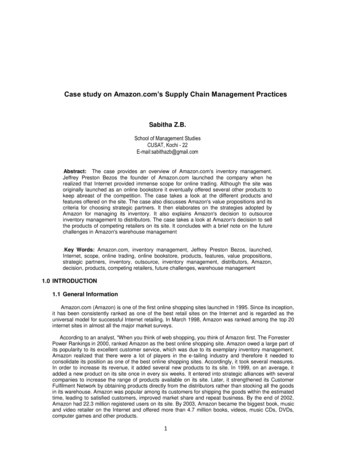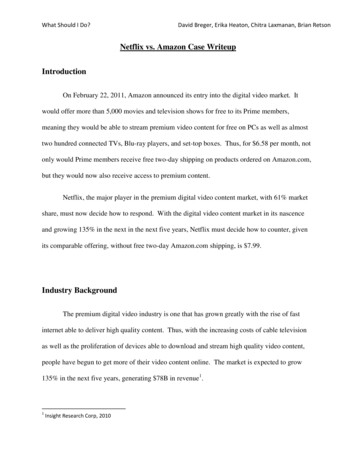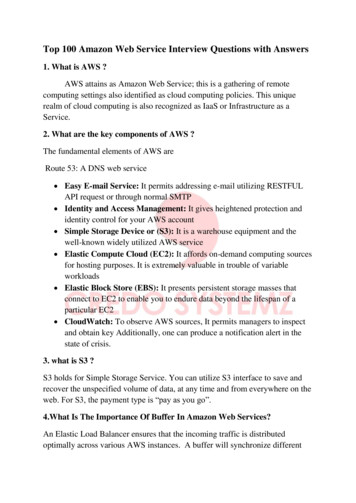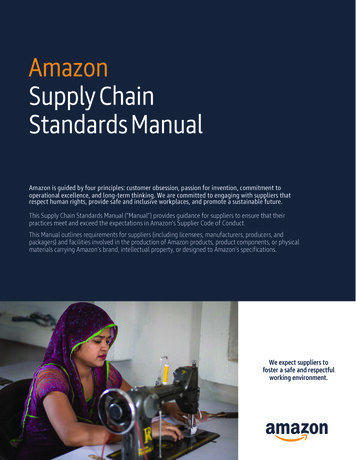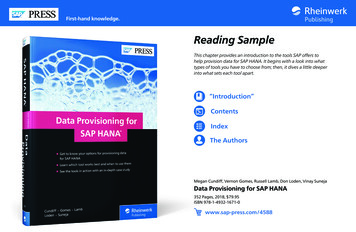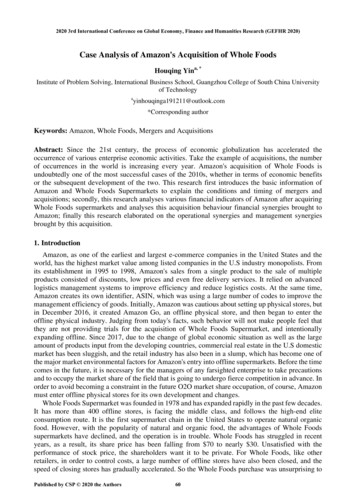
Transcription
2020 3rd International Conference on Global Economy, Finance and Humanities Research (GEFHR 2020)Case Analysis of Amazon's Acquisition of Whole FoodsHouqing Yina, *Institute of Problem Solving, International Business School, Guangzhou College of South China Universityof ding authorKeywords: Amazon, Whole Foods, Mergers and AcquisitionsAbstract: Since the 21st century, the process of economic globalization has accelerated theoccurrence of various enterprise economic activities. Take the example of acquisitions, the numberof occurrences in the world is increasing every year. Amazon's acquisition of Whole Foods isundoubtedly one of the most successful cases of the 2010s, whether in terms of economic benefitsor the subsequent development of the two. This research first introduces the basic information ofAmazon and Whole Foods Supermarkets to explain the conditions and timing of mergers andacquisitions; secondly, this research analyses various financial indicators of Amazon after acquiringWhole Foods supermarkets and analyses this acquisition behaviour financial synergies brought toAmazon; finally this research elaborated on the operational synergies and management synergiesbrought by this acquisition.1. IntroductionAmazon, as one of the earliest and largest e-commerce companies in the United States and theworld, has the highest market value among listed companies in the U.S industry monopolists. Fromits establishment in 1995 to 1998, Amazon's sales from a single product to the sale of multipleproducts consisted of discounts, low prices and even free delivery services. It relied on advancedlogistics management systems to improve efficiency and reduce logistics costs. At the same time,Amazon creates its own identifier, ASIN, which was using a large number of codes to improve themanagement efficiency of goods. Initially, Amazon was cautious about setting up physical stores, butin December 2016, it created Amazon Go, an offline physical store, and then began to enter theoffline physical industry. Judging from today's facts, such behavior will not make people feel thatthey are not providing trials for the acquisition of Whole Foods Supermarket, and intentionallyexpanding offline. Since 2017, due to the change of global economic situation as well as the largeamount of products input from the developing countries, commercial real estate in the U.S domesticmarket has been sluggish, and the retail industry has also been in a slump, which has become one ofthe major market environmental factors for Amazon's entry into offline supermarkets. Before the timecomes in the future, it is necessary for the managers of any farsighted enterprise to take precautionsand to occupy the market share of the field that is going to undergo fierce competition in advance. Inorder to avoid becoming a constraint in the future O2O market share occupation, of course, Amazonmust enter offline physical stores for its own development and changes.Whole Foods Supermarket was founded in 1978 and has expanded rapidly in the past few decades.It has more than 400 offline stores, is facing the middle class, and follows the high-end eliteconsumption route. It is the first supermarket chain in the United States to operate natural organicfood. However, with the popularity of natural and organic food, the advantages of Whole Foodssupermarkets have declined, and the operation is in trouble. Whole Foods has struggled in recentyears, as a result, its share price has been falling from 70 to nearly 30. Unsatisfied with theperformance of stock price, the shareholders want it to be private. For Whole Foods, like otherretailers, in order to control costs, a large number of offline stores have also been closed, and thespeed of closing stores has gradually accelerated. So the Whole Foods purchase was unsurprising toPublished by CSP 2020 the Authors60
experts who are familiar with the U.S. retail market, but simply they didn't expect amazon to be thebuyer. In the more than 30 years from its creation to its acquisition, it has accumulated acomprehensive information management system, standardized supply chain, and implementedstandard management, which coincides with Amazon's concept of standardized informationmanagement.Under such an environment, Amazon and Whole Foods have complementary needs, and thedouble win cooperation has become a goal for both parties to seek development. On the evening ofJune 16 2017, Beijing time, the largest fresh and organic food in the United States announced that ithas been acquired by Amazon, the largest e-commerce platform in the United States [1]. Theacquisition of Whole Foods (including its net debt) at a price of 42 was 13.7 billion, and isexpected to close in the second half of 2017.2. Literature ReviewThere are various forms of studies on corporate mergers and acquisitions (M&A). Researchscholars also divide them into different types of mergers and acquisitions to conduct researchaccording to different classification basis, so as to obtain various lessons and enlightenment. Thisarticle will describe the literature review on M&A of Whole Foods and Amazon.The academic circle has accumulated a lot of research on M&A theory. International scholarsbelieve that M&A is an important way for enterprises to seek development. It is a prominentphenomenon in the history of modern enterprise economic development that enterprises achieveexpansion through the acquisition of competitors [2]. But Chinese scholars believe that M&Asignificantly reduced the company's performance level by comparing the market response and theperformance of the company's financial indicators before and after the M&A event [3]. However, theexisting research cannot meet the practical needs of the rapid development of enterprises. Therefore,this paper reviews and discusses M&A again.As a matter of fact, research on Whole Foods supermarkets is also increasing day by day, includingresearch on standardized management and M&A strategies of Whole Foods supermarkets. Since itsestablishment, about one-third of the stores in Whole Foods have been acquired through acquisitions.While continuously expanding its market share through acquisitions, it has also clearly achievedsynergies [4]. As a result, Whole Foods continues to grow and mature, but due to fierce competitionfrom similar companies in recent years, the market share that was previously dominant has beenincreasingly decomposed, and Whole Foods has to seek a turnaround.At the same time, Amazon, the world's number one e-commerce company, is marching offline andis also looking for opportunities. Amazon was founded in 1995. At the beginning, it was just an onlinebookstore. However, through just 20 years of development and expansion, Amazon is now theworld's largest e-commerce website. The success of Amazon is inseparable from various forms ofmergers and acquisitions [5]. They summarized the history of Amazon's major mergers andacquisitions—acquisition of audiobook companies to occupy the audio download market; mergers ofaudiobook companies to occupy the audio download market; mergers and acquisitions ofself-publishing companies to expand business models; and merger stream automation to improvewarehousing efficiency; M&A of screen display technology company, research and development ofcolor Kindle; M&A of video game development company, want to enter the set-top box market, etc.Throughout the history of Amazon's mergers and acquisitions, it is not difficult to see the strategicintent. The industries of the acquired companies are all Amazon is ready to enter. These companieshave the conditions and status that Amazon needs to enter the industry [6]. Amazon's acquisitionstrategy is both offensive and defensive rather than defeating or confronting similar companies. It isbetter to buy what you need directly, which is also the highlight of Amazon's merger strategy.Similarly. Whole Foods is mainly engaged in organic fresh fruits and vegetables. For Amazon, this isa breakthrough in key categories. Chen Shu believes that for Amazon, the acquisition of Whole Foodscan enhance its offline strength, pass online advantages to offline, integrate online and offline, andform an omni-channel retail model [7].Based on the above research, in the following sections, we will discuss the acquisition from three61
aspects: financial synergy, operation synergy, and management synergy.3. Synegies analysisIn this section, firstly this research uses the basic financial data, prime operating revenue, primeoperating costs, gross profit and each of their year-on-year growth to discuss the influence which thisacquisition towards the cash flow. Secondly, this research analyses the change of Amazon’s stockprice fluctuation before and after this acquisition. And then this research discusses the effect ofAmazon’s financial ratios that this transaction brought to. Next two parts describe the operationsynergy and management synergy.3.1 Financial Synegy3.1.1 Basic Financial dataAfter the integration of the acquisition was completed, Amazon has more free cash flow from thecompany, reflecting the contribution of the acquisition store to the company's cash flow and profit,expanding the size of the company's assets and strengthening its capital strength.Table 1. Basic financial data before and after Amazon bought Whole 1Prime Operating Revenue51.04B60.45B43.74B37.96B35.71BYear-On-year Growth42.92%38.21%33.72%24.84%22.61%Prime Operating Costs30.73B38.49B27.55B23.45B22.44BYear-On-year Growth36.98%36.32%34.68%28.62%24.72%Gross Profit20.31B21.96B16.19B14.50B13.27BYear-On-year Growth52.98%48.54%41.39%29.22%29.35%Data source: http://quotes.sina.com.cn/usstock/hq/balance.php?s AMZNAmazon announced on June 16, 2017 that it would buy Whole Foods Market, an offline retailsupermarket, for 13.7 billion. Before the acquisition of Whole Foods, the worst thing Amazon soldonline was food and beverages. So this acquisition is considered an important step for Bezos toexpand its retail footprint. At the same time, the addition of Whole Foods Market has also drivenAmazon's revenue. The acquisition was consolidated in 17Q3. It can be seen that due to the WholeFoods' drive in the quarter, revenue growth has increased significantly (Table 1). Through Amazon'sJuly-September 2017 operating results announcement, it achieved a total of US 43.7 billion inoperating income, an increase of nearly 34% over the same period last year, of which revenue fromWhole Foods supermarkets was US 1.3 billion, accounting for 3% of overall revenue. And in thereport data of 2017 and 2018, it has maintained a high growth rate. During the same period, Amazon'soperating profit was 347 million, and 21 million came from Whole Foods, down 40% from thesame period last year. Among them, the increase in income is the highest in five years.3.1.2 Stock PriceProfit is a summary and re-presentation of the company's past operating performance and results,while the stock price more reflects investors' predictions of the company's future developmentprospects and profitability, and it also reflects whether the market is optimistic about the future of acompany good response. As shown in the Figure 1, Amazon's stock price has fluctuated since 2012.At the beginning of 2012, Amazon's share price was about 149. At the end of 2017, Amazon's stockprice rose 7% and returned to more than 1,000. The market value has also increased byapproximately 30 billion. As of February 2018, Amazon's stock price has reached 1528.70 pershare, an increase of 925.97% in more than six years. This alarming rise reflects the market's highexpectations for the future development prospects of Amazon after the acquisition of Whole Foods. Itcan also be seen from the above figure that even though the profit data of the 2017 financial reportreported by Amazon in February 2018 was not strong, the stock price still soared. This shows that themarket is optimistic that Amazon trades short-term profits for the market and focuses on long-term62
development.Amazon's stock 14Open1/3/15High1/3/16Low1/3/171/3/18CloseFigure 1. Amazon's stock price from 2012 to February 20183.1.3 Basic Financial RatiosTable 2. Financial ratios before and after Amazon bought Whole Foods20132014201520162017Accounts Receivable Turnover18.3117.1517.7818.4216.54Inventory Turnover8.067.997.738.138.14Current Assets Turnover3.243.183.163.313.36Fixed Assets Turnover8.276.385.525.344.56Total Assets Turnover2.051.881.781.831.66Data source: http://quotes.sina.com.cn/usstock/hq/balance.php?s AMZNAs shown in Table 2, there are five properties of financial ratios can be derived as the follows:(1) Turnover rate of accounts receivable. The greater the receivables turnover rate, the shorter thetime that Amazon's receivables are collected, the lower the probability of possible bad debt losses.Judging from these two tables, Amazon's accounts receivable turnover rate has been stable at around17 for a long time, which is a median level in the industry. Amazon's accounts receivable turnoverrate has been relatively stable, and has remained between 16% and 18.5% in the past five years. Itdeclined slightly in 2017, which may be due to Amazon's estimated sale of 11 million in the WholeFoods supermarket "365 Select" The brand's natural and organic products are far lower than theprivate label of other supermarket competitors.(2) Inventory turnover rate. As shown in the table above, Amazon's inventory turnover rate hasbeen very good in the past five years as a whole, stable at about 8, and the inventory turnover rate in2017 is at its highest level in the past five years. Reversing its worst sales decline since going publicin 1992. It has four "Whole Foods 365 Supermarkets", which are cheaper to build and operate thantraditional Whole Foods supermarkets, and also offer lower-priced products to young users.(3) Turnover rate of fixed assets. It can be seen from the above table that Amazon's fixed assetturnover rate indicator has performed poorly, and has declined year by year, from 8.27 in 2013 to 4.56in 2017. By analyzing the reasons for the poor performance of Amazon, it can be found that afterAmazon acquired Whole Foods, due to the establishment of a large number of warehousing andlogistics centers around the world and the purchase of a large number of equipment, its fixed assetturnover rate gradually decreased.(4) Turnover rate of total assets. Amazon's total asset turnover rate is generally at a declining level,indicating that Amazon's total asset utilization performance is not very good. It may also be affectedby this acquisition.63
3.2 Operational SynegiesThe acquisition of Whole Foods supermarkets not only means an increase in Amazon's source ofincome, but more importantly, it will collect more than 460 stores and transportation networks inprime locations where Whole Foods supermarkets are located, and let Amazon's series of onlineattempts floor space. Whole Foods is a leading natural food retailer in the United States, with 447 inthe United States, 9 in the UK, and 12 stores in Canada. Whole Foods has 440 frozen warehouses,which can cover 80% of the population in 10 miles. Coupled with retail stores with freezer cabinets, itcan reach 95% of Prime users. This means that even without any additional technological progress,just relying on these new distribution points, the operating rate of fresh food delivery can go upseveral steps. Due to the business model and brand concept of Whole Foods Supermarket, it is stillrelatively new to the American public, and it only has a small market share in the US market.According to Kantar Retail, less than 9% of U.S. households shop at Whole Foods each month, and 7%of them buy groceries at Whole Foods (0.63% of the total U.S. population). It is worth noting that 76%of Whole Foods customers shop on Amazon, and 12% of Amazon consumers will shop on WholeFoods. That is to say, Whole Foods Supermarket and Amazon's shoppers are highly coincident, andthe consumer growth opportunities brought by this acquisition will be geometric.3.3 Management SynegiesWhole Foods Supermarket is a good operator, but the system and technology investment isinsufficient. Amazon knows how to use technology to solve problems. They mastered the technologyof space travel, invented the Kindle reader, and deployed cloud computing. Making a grocery storebetter is not the most difficult problem they have ever encountered. Amazon will use its owntechnology to optimize Whole Foods supermarkets, such as Amazon Go's automatic checkouttechnology. In addition, Whole Foods has enriched the existing Amazon grocery categories, injectingnew value into the Amazon prime embership system. In the near future, shoppers will be able topurchase Whole Foods items via Amazon voice assistant Alexa and enjoy Amazon Prime Now's2-hour delivery service. Through a series of synergies generated by the complementary advantages ofthe two, Amazon can organically combine the three elements of convenience, value, and health tocomprehensively improve the shopper experience.4. ConclusionThrough the analysis of amazon's basic financial data and stock, we find that there are three areasof synergy: financial synergy, operation synergy, and management synergy. First of all, financialsynergy shows that after the acquisition is completed, Amazon has more company free cash flow,which reflects the contribution of the acquisition store to the company's cash flow and profit,expanding the scale of corporate assets and enhancing capital strength. Secondly, operation synergyshows that Amazon's acquisition of Whole Foods Supermarket means the acquisition of a largenumber of offline stores and a developed transportation network. Finally, management synergyshows that Amazon uses its own company's technical advantages to make up for the lack oftechnology in supermarkets in the city, and fully stimulates the operation advantages of Whole Foodssupermarkets. The combination of the two, taking advantage of the shortcomings, makes theoperation synergy perform perfectly.Amazon completed the acquisition of supermarkets in the city from the deployment of offlinephysical stores to the city's supermarkets, and finally completed the acquisition of Whole Foods onAugust 28, 2017 for 13.7B. After the acquisition, both sides of the merger and acquisition haveshown huge positive performance, meeting the needs of both parties [8]. After Amazon completed theacquisition of Whole Foods, Amazon has more company free cash flow, which shows that the effectof this acquisition on Amazon's cash and profit growth is very considerable; after completing theacquisition of Whole Foods, Amazon also has a large number of stores, expanding the scale of assetsand strengthening the strength of the company [9]; after Amazon completed the acquisition ofsupermarkets in the city, Amazon's stock price also increased significantly, such an amazing growth64
the speed and huge growth rate show that the market has very high expectations for Amazon'sdevelopment prospects; after Amazon completed the acquisition of supermarkets in the city, Amazonhas mastered the original stores in the city's more than 460 prime locations and developedtransportation network , so that a series of Amazon products can have room for landing; after Amazoncompletes the acquisition of supermarkets in the city, the advanced management mode ofsupermarkets in the city can be effectively played [10], especially after Amazon has used its ownadvantages to complete the supermarket After the management technology update.Until today, the corporate behavior of Amazon's acquisition of Whole Foods has become a topicoften mentioned by people in the industry. Based on the price of corporate mergers and acquisitionsand the outstanding performance of Amazon and Whole Foods after the merger, no one doubted thatthis was a successful merger. In addition, for increasingly powerful Chinese companies, especiallyChinese e-commerce companies that have performed well in recent years, Amazon’s acquisition ofWhole Foods can be said to be a very good lesson. The acquisition and integration of physical storeswith fairly excellent locations and transportation methods can provide a higher platform for thedevelopment of e-commerce companies. However, whether it can also achieve the financialperformance, management synergy and business synergy effects of Amazon in this case study isworth more people to investigate.AcknowledgementsThanks for the help from Dr. Ren and Dr. Cao in this paper writing process.References[1] Michael A. Cusumano. Amazon and Whole Foods: Follow the strategy (and the money).[J].Viewpoint, 2017, 60 (10): 24 - 26.[2] Abrams. R and Creswell. J. Amazon deal for Whole Foods starts a supermarket war [J]. TheWall Street Journal (June 16, 2017). 2017.[3] Stigler, G. J., 1950, “Monopoly and Oligopoly by Merger”. The American Economic Review,pp. 23 - 34.[4] Aaker, Jennifer L., 1997, “Dimensions of Brand Personality”, Journal of Marketing Research,pp. 347 - 367.[5] Xiang Jiangbo. Standardization and Informatization: Behind Amazon’s Acquisition of WholeFoods Supermarket [J]. Publication Reference, 2017, 11: 30 - 31.[6] Chen Shu. The "entity" strategy of e-commerce enterprises——Taking Amazon to buy WholeFoods as an example [J]. Business Economics Research, 2018, 10: 74 - 76.[7] Xu Lifang, Chi Cheng. Amazon: Growth History Based on M&A [J]. Digital Media Frontier,2014, 4: 20 - 21.[8] Lao Xiao, Amazon's acquisition of Whole Foods Supermarket: It's quite a big thing, but it's notso terrifying [J]. Economic & Trade Update, 2017, 23: 34 – 36.[9] Chen Zhipeng. M&A Case Study of Whole Foods Market in United States [D]. Institute ofFiscal Science, Ministry of Finance, Beijing, China, 2014.[10] Zhang Xin. Does M&A and Reorganization Realize Value?——Theoretical and EmpiricalResearch on China’s Securities Market [J]. Economic Research, 2003, 6.65
Amazon, Whole Foods, Mergers and Acquisitions. Abstract: Since the 21st century, the process of economic globalization has accelerated the occurrence of various enterprise economic activities. Take the example of acquisitions, the number of occurrences in the world is incr
